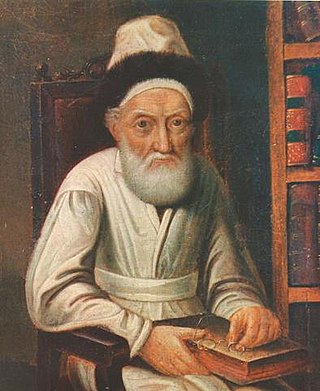
Menachem Mendel Schneersohn also known as the Tzemach Tzedek was an Orthodox rabbi, leading 19th-century posek, and the third rebbe of the Chabad Lubavitch Hasidic movement.

Modzitz, or Modzhitz, is the name of a Hasidic group within Orthodox Judaism that derives its name from Modrzyce, one of the boroughs of the town of Dęblin, Poland, located on the Vistula River.

Yisrael Meir Lau is a Holocaust survivor who served as the Ashkenazi Chief Rabbi of Israel from 1993 to 2003. He was previously Chief Rabbi of Tel Aviv, Israel. After his tenure as chief rabbi, he was appointed chairman of Yad Vashem.
Israel Isserlin was a Talmudist, and Halakhist, best known for his Terumat HaDeshen, which served as one source for HaMapah, the component of the Shulkhan Arukh by Moses Isserles. He is also known as Israel of Neustadt, Israel of Marpurk, and Maharai.

Moshe Yehoshua Yehuda Leib Diskin (1818–1898), also known as the Maharil Diskin, was a leading rabbi, Talmudist, and Biblical commentator. He served as a rabbi in Łomża, Mezritch, Kovno, Shklov, Brisk, and, finally, Jerusalem, after moving to Eretz Yisrael in 1878. He opened what today is known as the Diskin Orphan Home in 1881.
Rabbi Yehoshua Weitzman is an Israeli Rosh Yeshiva, heading Yeshivat Ma’alot Ya’akov, and prominent as a teacher and scholar of Torat Eretz Yisrael.
Joshua ben Perahiah or Joshua ben Perachya was Nasi of the Sanhedrin in the latter half of the 2nd century BC.
David ben Solomon ibn (Abi) Zimra (1479–1573) also called Radbaz (רַדְבָּ"ז) after the initials of his name, Rabbi David iBn Zimra, was an early Acharon of the fifteenth and sixteenth centuries who was a leading posek, rosh yeshiva, chief rabbi, and author of more than 3,000 responsa as well as several scholarly works.

Joshua ben Israel Benveniste was the brother of Chaim Benveniste, and a disciple of Joseph Trani. He was a physician and rabbi at Constantinople in 1660.

Avot de-Rabbi Nathan, usually printed together with the minor tractates of the Talmud, is a Jewish aggadic work probably compiled in the geonic era. Although Avot de-Rabbi Nathan is the first and longest of the "minor tractates", it probably does not belong in that collection chronologically, having more the character of a late midrash. In the form now extant it contains a mixture of Mishnah and Midrash, and may be technically designated as a homiletical exposition of the Mishnaic tractate Pirkei Avot, having for its foundation an older recension (version) of that tractate. It may be considered as a kind of "tosefta" or "gemarah" to the Mishna Avot, which does not possess a traditional gemarah. Avot de-Rabbi Nathan contains many teachings, proverbs, and incidents that are not found anywhere else in the early rabbinical literature. Other rabbinical sayings appear in a more informal style than what is found in Pirkei Avot.
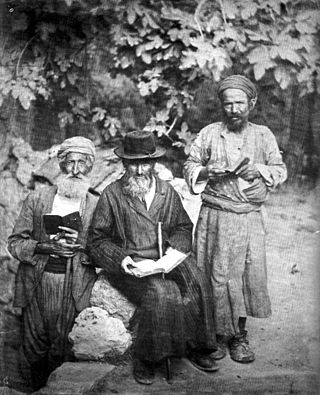
Yisroel ben Shmuel Ashkenazi of Shklov was a Lithuanian Jewish Talmudist, one of a group of Talmudical scholars of Shklov who were attracted to Vilna by Rabbi Elijah ben Solomon Zalman, known as the Vilna Gaon (1720–97). He was one of "the last arrivals," and attended upon the Gaon as a disciple for less than a year.
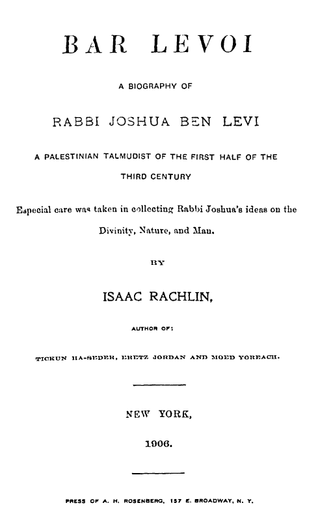
Joshua ben Levi was an amora, a scholar of the Talmud, who lived in the Land of Israel in the first half of the third century. He lived and taught in the city of Lod. He was an elder contemporary of Johanan bar Nappaha and Resh Lakish, who presided over the school in Tiberias. With Johanan bar Nappaha, he often engaged in homiletic exegetical discussions.
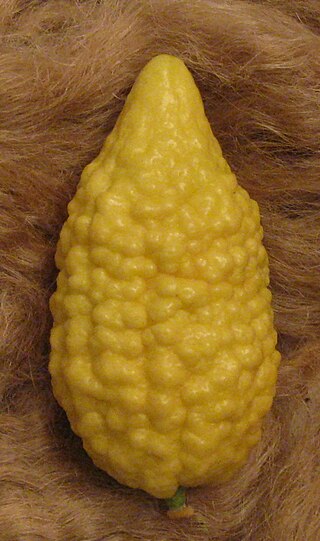
The balady citron is a variety of citron, or etrog, grown in Israel and Palestine, mostly for Jewish ritual purposes. Not native to the region, it was imported around 500 or 300 BCE by either Jewish or Greek settlers. Initially not widely grown, it was promoted and popularized in the 1870s by Rabbi Chaim Elozor Wax.
Chaim Elozor Wax was a well-known Hasidic rabbi, posek, and a Jewish leader in Poland. He was a philanthropist and accomplished student of the Talmud.
David Meir Frisch (c. 1812-April 25, 1882) was a 19th-century rabbinical authority.

Yehoshua Mondshine was an Israeli rabbi, scholar, researcher and historian associated with the Chabad-Lubavitch, Hasidic movement. Mondshine worked as a librarian and bibliographer at the National Library of Israel in Jerusalem.
Yehoshua Hanagid, alternative spelling: Jehoshua Hannagid (1310–1355), was a rabbinic scholar and judge, who began to serve as the Nagid in Cairo, Egypt, at the age of twenty-four. He was the fifth-generation descendant of Rabbi Moshe ben Maimon, the great Spanish Rabbi and philosopher. His full lineage is reckoned as Yehoshua, the son of Avraham, the son of David, the son of Avraham, the son Moshe ben Maimon.
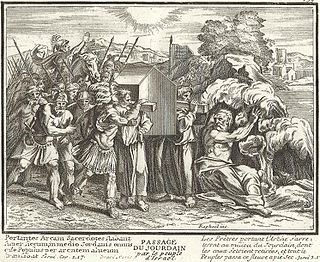
Yom HaAliyah, or Aliyah Day, is an Israeli national holiday celebrated annually according to the Jewish calendar on the tenth of the Hebrew month of Nisan to commemorate the Jewish people entering the Land of Israel as written in the Hebrew Bible, which happened on the tenth of the Hebrew month of Nisan. The holiday was also established to acknowledge Aliyah, immigration of Jews to the Jewish state, as a core value of the State of Israel, and honor the ongoing contributions of Olim, Jewish immigrants, to Israeli society. Yom HaAliyah is also observed in Israeli schools on the seventh of the Hebrew month of Cheshvan.
Rabbi Aharon Sorasky is a Haredi author in Israel, his specialty being biographies about Orthodox rabbis. He has also written under the pseudonym A. Safran.
Rabbi Mordechai Jaffe of Lechovitch was a Hasidic rabbi who was the disciple of Rabbi Shlomo of Karlin and was the founder of the Lechovitch dynasty of Hasidism, from which the Kobrin, Slonim, Koidanov, and Novominsk courts descended. He was the president of the Holy Land Fund for Jews in Israel.










